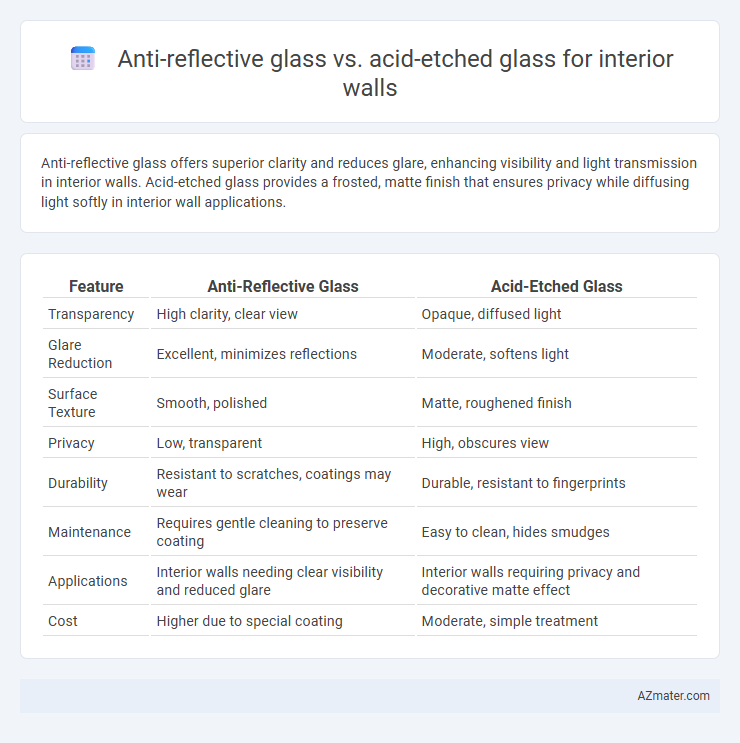Anti-reflective glass offers superior clarity and reduces glare, enhancing visibility and light transmission in interior walls. Acid-etched glass provides a frosted, matte finish that ensures privacy while diffusing light softly in interior wall applications.
Table of Comparison
| Feature | Anti-Reflective Glass | Acid-Etched Glass |
|---|---|---|
| Transparency | High clarity, clear view | Opaque, diffused light |
| Glare Reduction | Excellent, minimizes reflections | Moderate, softens light |
| Surface Texture | Smooth, polished | Matte, roughened finish |
| Privacy | Low, transparent | High, obscures view |
| Durability | Resistant to scratches, coatings may wear | Durable, resistant to fingerprints |
| Maintenance | Requires gentle cleaning to preserve coating | Easy to clean, hides smudges |
| Applications | Interior walls needing clear visibility and reduced glare | Interior walls requiring privacy and decorative matte effect |
| Cost | Higher due to special coating | Moderate, simple treatment |
Introduction to Anti-Reflective and Acid-Etched Glass
Anti-reflective glass minimizes glare and enhances light transmission, making it ideal for interior walls requiring clarity and visual comfort. Acid-etched glass features a frosted appearance created by chemical treatment, providing privacy while maintaining translucency. Both materials offer unique aesthetic and functional benefits tailored to different interior design needs.
Key Differences Between Anti-Reflective and Acid-Etched Glass
Anti-reflective glass reduces glare and enhances clarity by minimizing surface reflections, making it ideal for maintaining visibility and natural light in interior walls. Acid-etched glass offers a frosted, translucent finish that provides privacy while diffusing light softly, contributing to a more subdued ambiance. Key differences center on functionality: anti-reflective glass prioritizes clarity and transparency, whereas acid-etched glass emphasizes texture and privacy through surface treatment.
Aesthetic Appeal: Visual Qualities Compared
Anti-reflective glass offers exceptional clarity and minimal glare, enhancing interior walls with crisp, transparent visual appeal that maximizes natural light and depth perception. Acid-etched glass provides a soft, frosted finish that diffuses light gently, creating a muted, elegant ambiance with a textured surface that adds subtle visual interest and privacy. While anti-reflective glass emphasizes sleek modernity and unobstructed views, acid-etched glass introduces a tactile, artistic element suited for decorative and intimate interior spaces.
Light Transmission and Visual Clarity
Anti-reflective glass maximizes light transmission by reducing surface reflections, providing clear and vivid visual clarity ideal for interior walls where brightness and transparency are essential. Acid-etched glass diffuses light by scattering it, resulting in lower light transmission but enhanced privacy with a frosted appearance that obscures detailed views. Choosing between the two depends on prioritizing either optimal clarity and brightness with anti-reflective glass or softened light diffusion with acid-etched glass for privacy.
Privacy Levels and Applications
Anti-reflective glass offers high clarity with minimal glare, making it ideal for office partitions and spaces requiring clear visibility while maintaining privacy through strategic placement or additional treatments. Acid-etched glass provides a frosted, opaque surface that enhances privacy by diffusing light and obscuring vision, commonly used in conference rooms, bathrooms, and private areas. Applications choosing between these glass types balance privacy needs against light transmission and aesthetic preferences, with anti-reflective glass favoring transparency and acid-etched glass prioritizing seclusion.
Durability and Maintenance Requirements
Anti-reflective glass offers superior durability with a hardened surface that resists scratches and maintains clarity over time, requiring minimal maintenance typically involving gentle cleaning with non-abrasive solutions. Acid-etched glass, while aesthetically pleasing with its matte finish, is more prone to surface damage and can accumulate dirt in its textured patterns, necessitating more frequent and careful cleaning to preserve its appearance. Both options provide unique visual effects for interior walls, but anti-reflective glass stands out for long-term durability and lower maintenance demands.
Cost Considerations and Budgeting
Anti-reflective glass typically incurs higher costs due to specialized coatings that reduce glare and enhance clarity, making it a premium choice for interior walls with strong lighting needs. Acid-etched glass offers a more budget-friendly alternative by providing a frosted, translucent effect without the complex manufacturing process, resulting in lower material and installation expenses. Budgeting should consider long-term maintenance costs, as anti-reflective coatings may require careful cleaning and potential reapplication, whereas acid-etched glass is more durable and easier to maintain.
Design Flexibility and Customization Options
Anti-reflective glass offers superior clarity and minimal glare, enhancing interior wall designs with sleek, modern aesthetics and allowing for vibrant, unobstructed visuals. Acid-etched glass provides a versatile palette of textures and opacity levels, enabling designers to create privacy features, intricate patterns, and diffused light effects tailored to specific spaces. Both materials support customization, but acid-etched glass excels in offering creative control through varied etching depths and designs, while anti-reflective glass emphasizes clean, transparent finishes.
Ideal Use Cases for Interior Walls
Anti-reflective glass is ideal for interior walls in spaces that prioritize maximum clarity and minimal glare, such as office partitions, showrooms, and art galleries, enhancing visibility while reducing eye strain. Acid-etched glass suits applications requiring privacy and a soft, diffused light effect, making it perfect for conference rooms, bathrooms, and private office spaces where subtle texture and light control are desired. Both materials complement modern interior design by balancing aesthetic appeal and functional performance tailored to specific privacy and light transmission needs.
Choosing the Right Glass for Your Interior Space
Choosing the right glass for your interior wall depends on the desired aesthetics and functionality; anti-reflective glass reduces glare and enhances clarity, making it ideal for spaces requiring clear visibility and natural light flow. Acid-etched glass offers a frosted, opaque finish that provides privacy while still allowing light diffusion, perfect for creating secluded areas without darkening the room. Consider the balance between transparency, light transmission, and privacy needs to select the glass type that best complements your interior design and space usage.

Infographic: Anti-reflective glass vs Acid-etched glass for Interior wall
 azmater.com
azmater.com